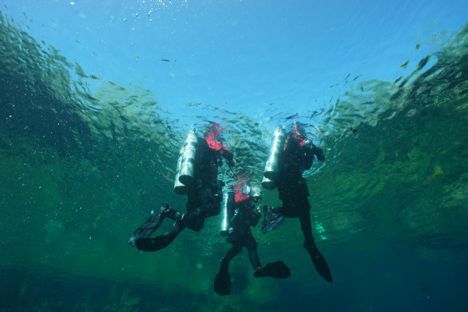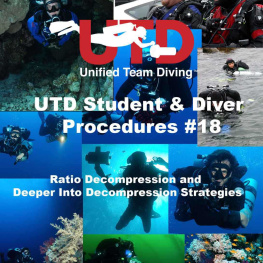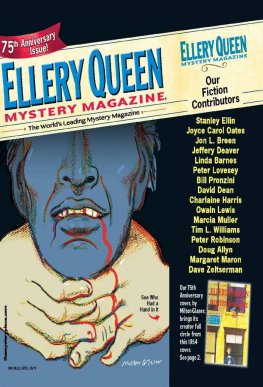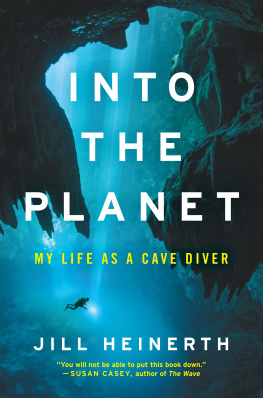UTD Student and Diver Procedures Manual - Ratio Deco
v 1.0
2011 UTD International, LLC
All rights reserved
Written by
Andrew Georgitsis and Jeff Seckendorf
UTD International, LLC
Carlsbad, CA USA
www.unifiedteamdiving.com
Forward
Welcome to the UTD Student and Diver Procedures Manual . This book outlines, in detail, each of the skills, procedures and protocols as set by Unified Team Diving and its teachings. This manual will help you the recreational, technical, overhead, or rebreather diver or student understand each procedure we consider critical to proper and safe diving, and will enable you to achieve your goal of being a strong, thinking diver.
The Student and Diver Procedures Manual offers a written explanation and documentation standardizing the various student and diver procedures and protocols. You will find the sections divided into
- Normal Procedures
- Student Drill Procedures
- Emergency procedures
- Bulletins and Papers
- Checklists and Worksheets
UTD also publishes a series of videos to help you visualize the skill sets. Ultimately, our online classes and printed student class materials support our certification classes.
So go ahead, get started and enjoy. Unified Team Diving provides an online forum at www.unifiedteamdiving.com as a place to ask more questions and get answers from UTD instructors and others in the community. If you still have unanswered questions, feel free to email us at info@unifiedteamdiving.com.
Safe Diving,
Andrew Georgitsis and Jeff Seckendorf
Acknowledgements
We gratefully acknowledge the contributions made to this document by the following UTD Instructors:
Maciej Arkuszewski
Emanuela Bertoni
Don Chennavasin
Poh Chang Chew
Kristof Damen
Casper Driee
Jeanna Edgerton
Mark Gottfried
Dave Harris
Adam Korytko
Hunter Lacey
James Mott
Nick Toussaint
Todd Powell
George Watson
Brian Wiederspan
Thank you to Nick Ambrose and Jeanna Edgerton for providing some of the photographs that illustrate this book.
Table of Contents
Preface Introduction
Bulletins and Papers
Chapter 18 Ratio Deco
Preface
Background
By understanding UTDs roots and background, you will see our vision and the future of UTD Training, Adventures and Equipment. Looking back into the early 1990s, there was an equipment configuration style emerging from the North Florida cave diving community called Hogarthian. At that time the community of technical, wreck, and cave divers was very small, yet very divided. There were many opinions on how to configure the equipment the right way, often implying everyone else was diving wrong. Even within the Northern Florida and U.S. east coast diving communities, there were many technical, wreck, and cave divers who were configuring in a variety of ways from stuffed long hoses, to independent doubles, to multiple regulator systems on a single stage tank, to a multitude of convoluted and difficult to comprehend systems.
The Hogarthian configuration, named after Bill Hogarth Main, emerged at about the same time as the internet chat forums and boards. This allowed the word to spread about a configuration that was minimalist, clean, simple, and well thought out. The system was soon adopted by a cave exploration team called Woodeville Karst Plain Project (WKPP). Their project director at that time, George Irvine III, started to instill the configuration into his team and diving protocols. His passion for exploration, his extreme dedication to WKPP, and his personality led him to become very ridged in his approach to applying the Hogarthian configuration and demanding a team approach to exploration of the Wakulla Springs cave system.
In an article published in the late 1990s in Aquanaut magazine, a technical dive magazine, Irvine coined the term DIR, or Doing It Right. In this article he pushed the idea of not only utilizing a consistent, scalable, streamlined and minimalist configuration mimicked after the Hogarthian configuration, but drove the idea that DIR was a complete team approach to conducting a dive. That included everything from a consistent equipment configuration, to the consistent selection of the gases, decompression strategy, skill set and so on. DIR was born.
As the scope of the WKPP cave pushes became more and more complicated, the need for the team to all be on the same page and also be the source of backup equipment became more obvious. This drew national and then international attention. WKPP was achieving what others could not by utilizing a DIR approach to the project and/or dives.
At the same time, some of the upper level WKPP members, together with lead push diver Jarrod Jab-lonski and UTD founder Andrew Georgitsis, developed a training organization to teach and solidify the DIR approach. This teaching methodology would consist of an equipment configuration (modeled after the Hogarthian style), a foundational diving skill set taken from cave diving, and procedures and protocols culled from the WKPP methodology. Ultimately this is what became taught as the DIR approach.
For 10 years, UTD founder Andrew Georgitsis, was the training director for this organization, developing the standards and procedures, training protocols and the senior instructors. In 2006 Georgitsis broke away to develop and pursue his vision of the Unified Team. Although DIR has many ten-ants that are excellent and make a great foundation of which to build your diving skills, the extreme rigidity and lack of expandability beyond open-circuit back gas doubles and deco/stage bottles became limiting. In 2008 Georgitsis and Jeff Seckendorf teamed up, and Unified Team Diving (UTD) was born.
UTD is a progressive training agency with roots in DIR. To that end, we continue to teach a very consistent DIR open circuit program, from our Open Water and Recreational 1basic certification classes, through more advanced recreational diving, technical, trimix, cave, wreck, and rebreather.
Our open water students learn the same team procedures, same emergency procedures, same gas planning and ascent procedures as our Trimix students. This means there is a consistent path to all training within the agency. There is no need for students to replace gear, or learn new protocols as they move though more advanced classes. Each class advances on the previous, adding to the students experience as they move to deeper and more complicated diving, such as overhead cave and wreck environments.
UTD then pioneered the integration of other diving disciplines into the UTD/DIR approach, including the MX Series mCCR Rebreather, a fully closed circuit manual rebreather, based on designs and disciplines learned, taught and propagated by Andrew Georgitsis and other WKPP members using pSCR rebreathers in exploration during the late 1990s and early 2000s. This is a UTD/DIR compatible configuration for a rebreather, allowing a mixed team of open circuit and closed circuit divers to seamlessly function as a team gas planning, ascent strategy, and emergency procedures are all similar.
This question often arises: Why does UTD care about mixed team protocols? Simply put, this should be the cornerstone of any rebreather configuration and design. In other words, almost every emergency on a rebreather leads to an open circuit bailout therefore, by default, the team has to deal with the emergency and exit as a mixed team. Knowing, practicing, and ensuring the team understands the proper protocols and procedures of mixed-team diving is essential in these emergency bailout situations.




![Dzheffri Diver - Where the Evidence Lies [A Lincoln Rhyme Short Story]](/uploads/posts/book/875547/thumbs/dzheffri-diver-where-the-evidence-lies-a-lincoln.jpg)




